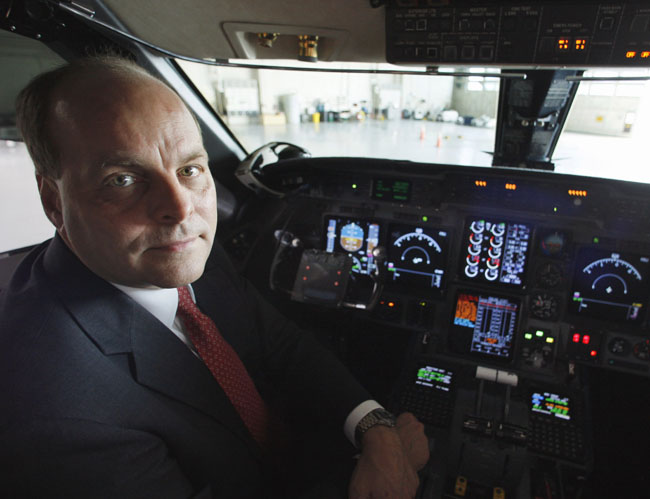FAA: An agency in trouble
Tuesday, April 19, 2011
 Former Federal Aviation Administration Chief Operating Officer Hank Krakowski poses in the cockpit of an FAA jet in a hangar at Washington's Reagan National Airport. Krakowski, the official who oversees the nation's air traffic system resigned Thursday and the FAA began a "top to bottom" review of the entire system following disclosures of four instances of air traffic controllers sleeping on the job.
(AP Photo/Charles Dharapak, File)
Former Federal Aviation Administration Chief Operating Officer Hank Krakowski poses in the cockpit of an FAA jet in a hangar at Washington's Reagan National Airport. Krakowski, the official who oversees the nation's air traffic system resigned Thursday and the FAA began a "top to bottom" review of the entire system following disclosures of four instances of air traffic controllers sleeping on the job.
(AP Photo/Charles Dharapak, File)Sleeping on the job takes on new meaning when the individual doing the sleeping is a lone air traffic controller in a tower at the time an airplane is ready to land. No one is quite sure how common the incidence of sleeping controllers might be, but disclosure of a series of incidents in the last couple of months suggests that it is more frequent than commonly acknowledged. As it is, revelation of the recent events has created widespread worry about the safety of the nation's air control system. The concern is understandable.
Most Americans know that there are a lot of planes in the air every day, but exact totals are astounding. Officials generally agree that, on average, there are thousands of planes in the air above the United States at any given moment, with a cumulative total of about 87,000 flights a day. That's a heavy workload by any measure, and any inattention - sleeping, napping, chatting on the phone - on the part of controllers is a potential threat to those who pilot aircraft and travel on them.
Commercial flights form the bulk of the air traffic system's workload, but not all of it. Controllers handle about 28,000 commercial flights a day. They also are responsible for about 27,000 general aviation (private aircraft) flights, about 24,000 air taxi (planes for hire) flights and about 8,000 additional daily flights that include military and air cargo (UPS, Federal Express and similar carriers). A Web site for the national association says air traffic controllers manage about 64 million takeoffs and landings yearly. That's a lot of work for an overextended staff.
Obviously, almost every one of those takeoffs and landings take place without incident. Still, reports that even a handful were put in danger since mid-February by sleeping controllers in Knoxville; Washington, D.C.; Lubbock, Texas; Seattle, Wash.; Reno. Nev., and last Saturday at a regional control center in Florida are too many. Some pilots were able to land without assistance and others were guided to a landing by a nearby regional facility. That's not the way the system is supposed to operate.
The recent events stirred the usually inertia-bound Federal Aviation Administration into action. It disciplined or fired some controllers, and it changed policies so that two controllers rather than one now work overnight shifts at many airports. The head of the nation's air traffic system resigned, and Randy Babbitt, chief of the FAA, has said, most recently on Monday, that a sweeping review of the system is planned. That's too little, too late.
FAA officials were warned about the problem of controller fatigue years ago, but ignored the issue. Of course, it's hard for Babbitt and others to disregard a string of incidents that directly threaten air safety. Talk is fine, but prompt and meaningful action is required.
The FAA will have to overcome its traditional inertia. It and the public should push Congress to appropriate funds to replace aging technology with the up-to-date systems that have long been recommended. The legislators' long-term refusal to provide the funds needed is shortsighted and misguided. Congress should reverse course and open the purse strings - before a rebounding economy and the resultant increase in air traffic pushes a strained system to the point where a napping controller prompts a disaster rather than an incident that, despite its seriousness, ends without loss of life.